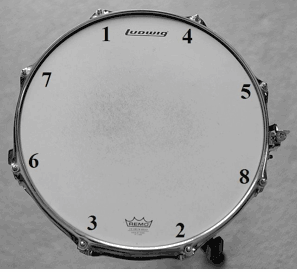Hello everybody, I'm new to the forum and new to drumming as well. I'll try to make this short.
So... I rented a drum set about 3 weeks ago because I've always wanted to try it, and now, I'm hooked for life. 100%.
So on this rented kit... After a week of messing around and learning rudiments, I noticed some very unpleasant harmonics coming from the snare, and when I would hit the hi-tom when no other drums were resonating, I was also hearing an unpleasant resonance from the mid-tom reacting to the hi-tom. I tried to make some adjustments myself, and just ended up making it worse.
Now these drums are completely unplayable, my cat even came downstairs and started meowing at me! (that's not normal from him, it was definitely the overtones)
In the last couple of weeks, I've looked up a lot of videos online about tuning, and I'm looking for more technical advice on the subject.
" finger tighten and then eighth/quarter turn around" didn't help me, so I'm looking to have a few questions answered.
1 - Can this be done without knowing exactly what a "C" or "D" pitch is? because I do not know how to do that without a tuner. My ears are not trained.
2 - How do you tune the drums as a whole, and when do you know when the intervals are correct with each other?
3 - If you're tuning the entire kit, do you have to remove the drum and tune it away from the others?
4 - How do you know when the drum is tuned to it's optimal pitch?
Anything helps, the more technical, the better.
Thanks for your time.
So... I rented a drum set about 3 weeks ago because I've always wanted to try it, and now, I'm hooked for life. 100%.
So on this rented kit... After a week of messing around and learning rudiments, I noticed some very unpleasant harmonics coming from the snare, and when I would hit the hi-tom when no other drums were resonating, I was also hearing an unpleasant resonance from the mid-tom reacting to the hi-tom. I tried to make some adjustments myself, and just ended up making it worse.
Now these drums are completely unplayable, my cat even came downstairs and started meowing at me! (that's not normal from him, it was definitely the overtones)
In the last couple of weeks, I've looked up a lot of videos online about tuning, and I'm looking for more technical advice on the subject.
" finger tighten and then eighth/quarter turn around" didn't help me, so I'm looking to have a few questions answered.
1 - Can this be done without knowing exactly what a "C" or "D" pitch is? because I do not know how to do that without a tuner. My ears are not trained.
2 - How do you tune the drums as a whole, and when do you know when the intervals are correct with each other?
3 - If you're tuning the entire kit, do you have to remove the drum and tune it away from the others?
4 - How do you know when the drum is tuned to it's optimal pitch?
Anything helps, the more technical, the better.
Thanks for your time.
Last edited:


